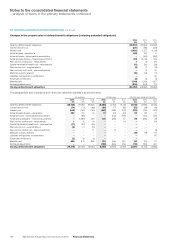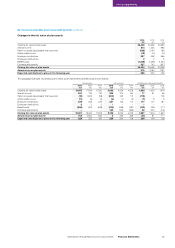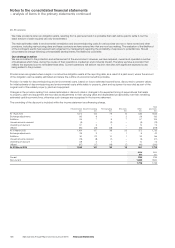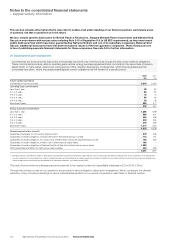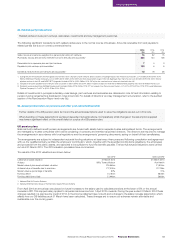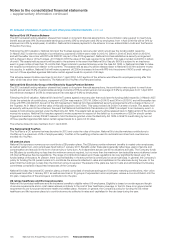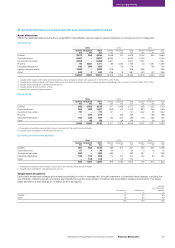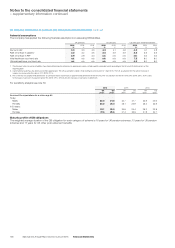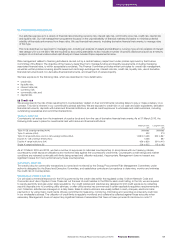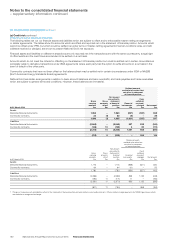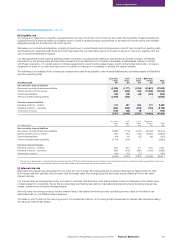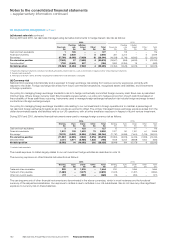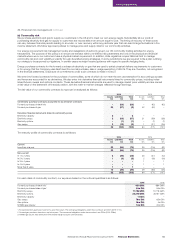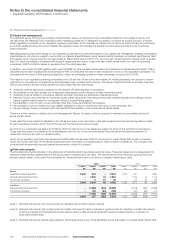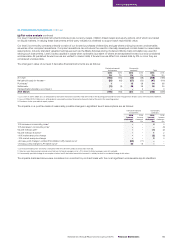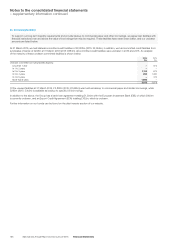National Grid 2016 Annual Report Download - page 148
Download and view the complete annual report
Please find page 148 of the 2016 National Grid annual report below. You can navigate through the pages in the report by either clicking on the pages listed below, or by using the keyword search tool below to find specific information within the annual report.29. Actuarial information on pensions and other post-retirement benefits continued
National Grid UK Pension Scheme
The 2013 actuarial funding valuation showed that, based on long-term financial assumptions, the contribution rate required to meet future
benefit accrual was 36% of pensionable earnings (currently 33% by employers and 3% by employees; from 1 April 2016 this will be 31% by
employers and 5% by employees). In addition, National Grid makes payments to the scheme to cover administration costs and the Pension
Protection Fund levy.
Following the 2013 valuation, National Grid and the Trustees agreed a recovery plan which would see the funding deficit repaid by
31March2027. Under the schedule of contributions, payments of £60m were made in 2013/14, £99m in 2014/15 and £100m in 2015/16,
andwill thereafter rise in line with RPI until 2026/27. As part of the 2013 agreement, National Grid has established a security arrangement
withacharge in favour of the Trustees. At 31 March 2016 the value of this was required to be £427m. This was provided via £427m in letters
ofcredit. The assets held as security will be paid to the scheme in the event that National Grid Gas plc (NGG) is subject to an insolvency
event,is given notice of less than 12 months that Ofgem intends to revoke its licence under the Gas Act 1986, or National Grid fails to make
therequired contributions in relation to the scheme. The assets held as security will be released back to National Grid if the scheme moves
intosurplus. In addition, National Grid will make a payment of £200m (increased in line with RPI) into the scheme if NGG’s credit rating by
twoout of three specified agencies falls below certain agreed levels for a period of 40 days.
This scheme ceased to allow new hires to join from 1 April 2002. A DC section of the scheme was offered for employees joining after this
date,which has since been replaced by The National Grid YouPlan (YouPlan) (see below).
National Grid Electricity Group of the Electricity Supply Pension Scheme
The 2013 actuarial funding valuation showed that, based on long-term financial assumptions, the contribution rate required to meet future
benefit accrual was 33.4% of pensionable earnings (currently 27.5% by employers and an average of 5.9% by employees; from 1 April 2016
thiswill be an average of 26.5% by employers and an average of 6.9% by employees).
Following the 2013 valuation, National Grid and the Trustees agreed a recovery plan that would see the funding deficit repaid by 31 March 2027.
Under the schedule of contributions, a payment of £80m was made in 2013/14, £46m in 2014/15 and £47m in 2015/16, and will thereafter rise
in line with RPI until 2026/27. As part of the 2013 agreement, National Grid has established security arrangements with a charge in favour of
theTrustees. At 31 March 2016 the value of this was required to be £150m. This was provided via £150m in a letter of credit. The assets held
assecurity will be paid to the scheme in the event that National Grid Electricity Transmission plc (NGET) is subject to an insolvency event, or
ceases to hold a licence granted under the Electricity Act 1989. The assets held as security will be released back to National Grid if the scheme
moves into surplus. National Grid has also agreed to make a payment in respect of the deficit up to a maximum of £500m should certain
triggers be breached; namely if NGET ceases to hold the licence granted under the Electricity Act 1989 or NGET’s credit rating by two out
ofthree specified agencies falls below certain agreed levels for a period of 40 days.
The scheme closed to new members from 1 April 2006.
The National Grid YouPlan
The YouPlan is a DC scheme that was launched in 2013 and under the rules of the plan, National Grid double matches contributions to
YouPlan up to a maximum of 6% of employee salary. YouPlan is the qualifying scheme used for automatic enrolment and new hires are
enrolled into YouPlan.
US pension plans
National Grid sponsors numerous non-contributory DB pension plans. The DB plans provide retirement benefits to vested union employees,
aswell as vested non-union employees hired before 1 January 2011. Benefits under these plans generally reflect age, years of service and
compensation and are paid in the form of an annuity or lump sum. An independent actuary performs valuations annually. The Company funds
the DB plans by contributing no less than the minimum amount required, but no more than the maximum tax deductible amount allowed under
US Internal Revenue Service regulations. The range of contributions based upon these regulations can vary significantly based upon the
funded status of the plans. At present, there is some flexibility in the amount that is contributed on an annual basis. In general, the Company’s
policy for funding the US pension plans is to contribute the amounts collected in rates and capitalised in the rate base during the year, to the
extent that the funding is no less than the minimum amount required. The assets of the plans are held in trusts and administered byfiduciary
committees comprised of appointed employees of the Company.
National Grid also has several DC pension plans, primarily comprised of employee savings and Company matching contributions. Non-union
employees hired after 1 January 2011, as well as new hires in 10 groups of represented union employees, receive a core contribution into the
DC plan, irrespective of the employee’s contribution into the plan.
US retiree healthcare and life insurance plans
National Grid provides healthcare and life insurance benefits to eligible retired US employees. Eligibility is based on certain age and length
ofservice requirements and in most cases retirees contribute to the cost of their healthcare coverage. In the US, there is no governmental
requirement to pre-fund post-retirement health and welfare plans. However, in general, the Company’s policy for funding the US retiree
healthcare and life insurance plans is to contribute amounts collected in rates and capitalised in the rate base during the year.
146 National Grid Annual Report and Accounts 2015/16 Financial Statements
Notes to the consolidated financial statements
– supplementary information continued


